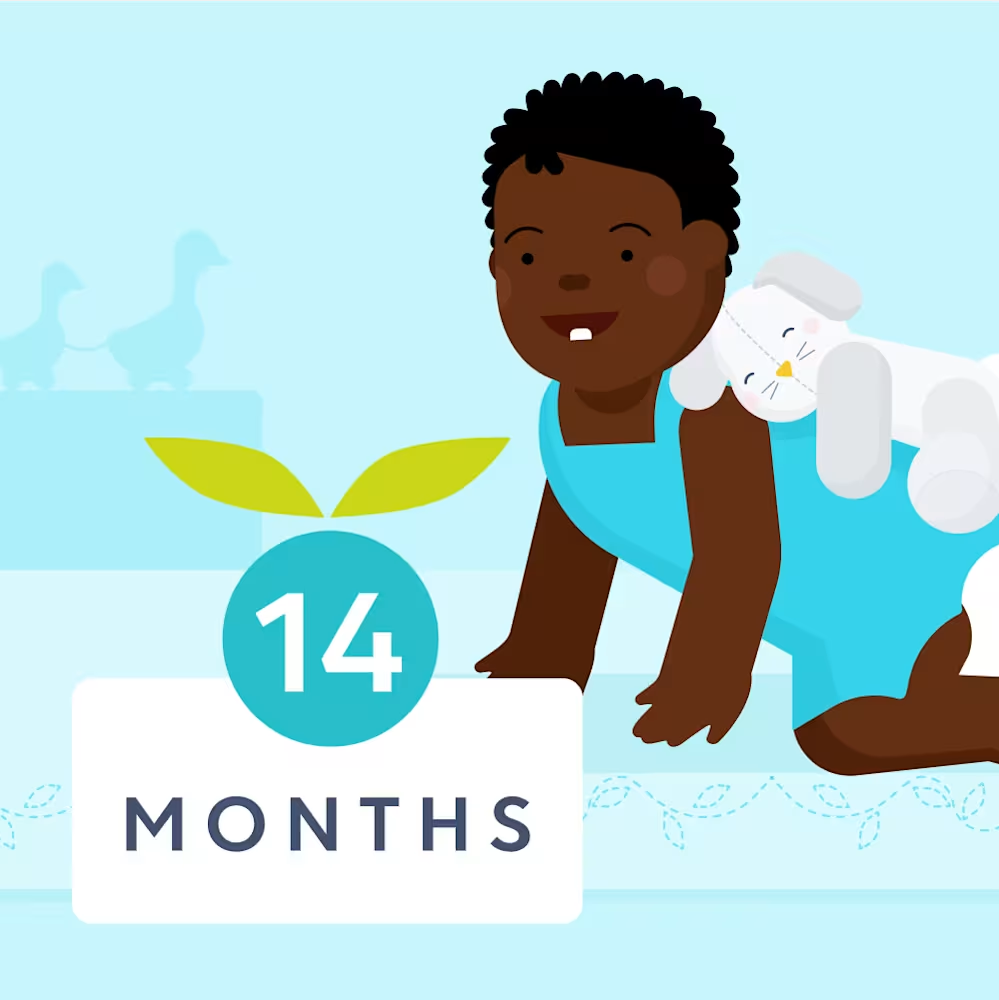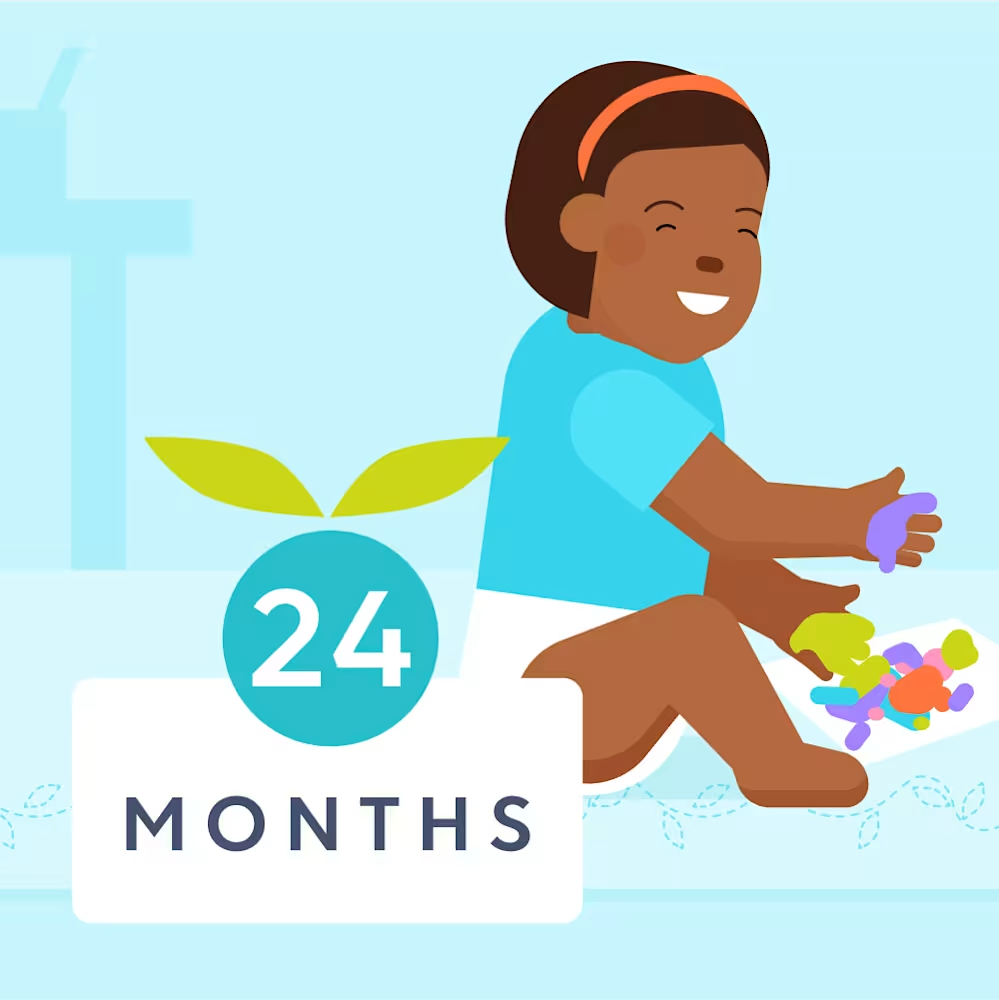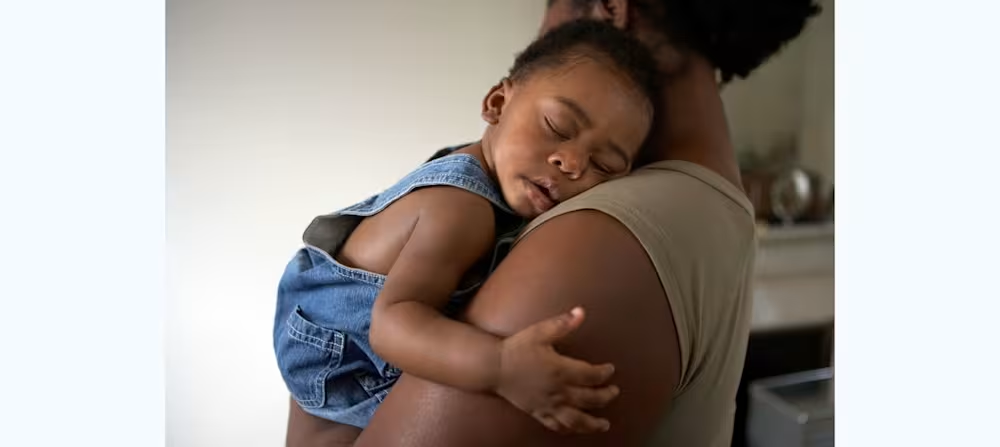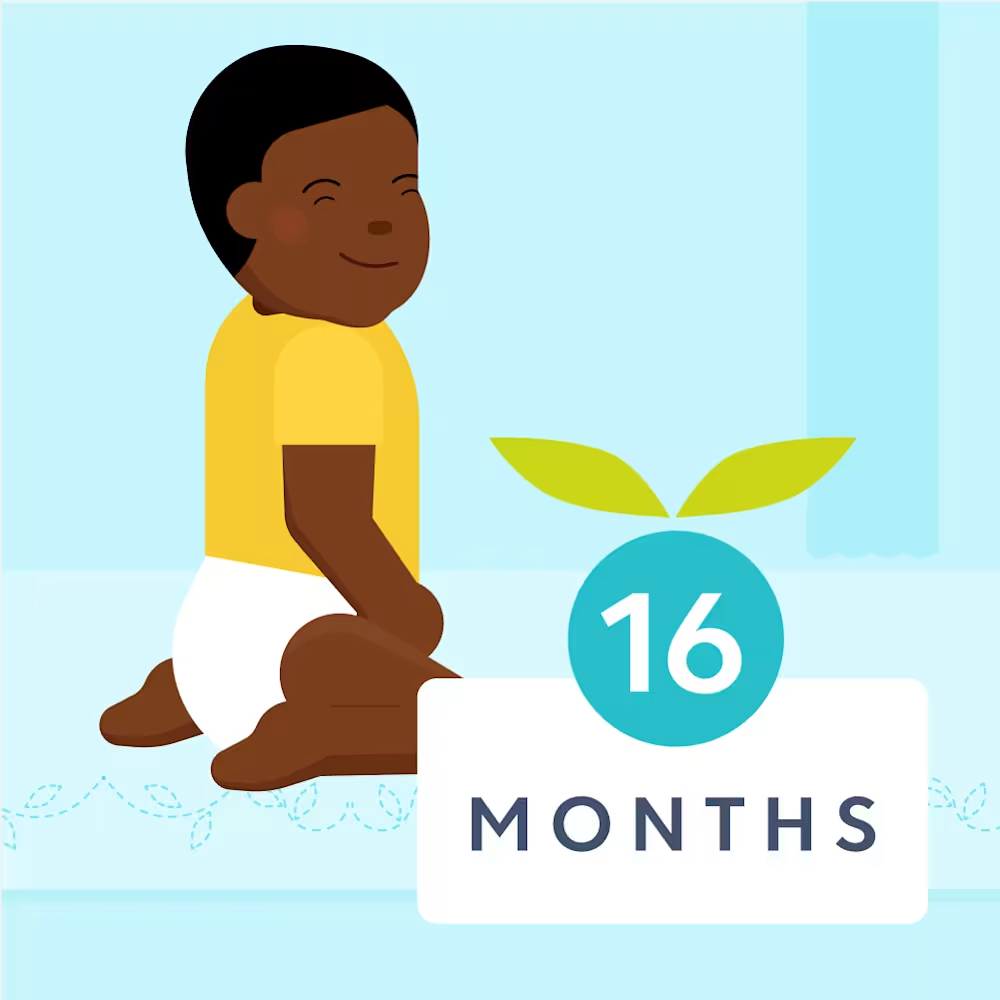14 month old toddler milestones: Development, growth, speech, language
Updated Dec 29, 2025

It’s exciting to watch your child learn and grow at 14 months! This is a period of development that can include children taking independent steps and trying to say a couple of words. At this age, many children are also learning to feed themselves and show affection. They’re also wanting to assert their independence more, which inevitably leads to frustration and tantrums.
In this article, we’ll take you through the milestones you can expect from 14 month old children, give you a handy 14 month old development checklist, and provide useful tips to help ensure your little one is learning and growing as much as possible.
Editor's note
When we discuss toddlers and development at Huckleberry, we use their adjusted age (vs. actual age). Not all children will reach 14 month old milestones simultaneously — and that’s normal. There’s a wide spectrum when it comes to how fast kids grow and develop. While many children do reach these milestones by 14 months, this isn’t always the case. If you have any concerns or questions about your child’s development, reach out to their pediatrician.
Table of Contents
14 month old toddler milestones at a glance
Development:
14 months is an exciting age that usually includes milestones like walking, trying to say words, showing interest in toys and other objects, giving hugs and kisses, and communicating interest in things by pointing and clapping. Children at 14 months are often trying to assert their independence through activities like eating and getting dressed, even though they still need some help. Sometimes this desire for control leads to temper tantrums. Though frustrating, tantrums are a normal part of toddler development.
Sleep:
At 14 months, around 13.25 hours of sleep over a 24-hour period. This includes 10 - 12 hours of overnight sleep and around 2 - 3 hours of sleep during the day, split between 1 or 2 naps. Note that this recommendation is a guideline and it’s equally important to monitor your child’s mood and energy levels when evaluating their sleep needs. All kids are different, even when it comes to sleep.
Naps for toddlers at 14 months can be quite varied at this age. Some children will drop to 1 nap per day at this age, while others will do best continuing with 2 naps per day for a while longer. The 2-to-1 nap transition generally happens between , so it may be on the horizon if your little one is still taking two naps.
Signs that they are ready to drop a nap include suddenly taking short naps, resisting daytime sleep, or consistently sleeping less than 10 hours at night. These are often signs that your child is ready for longer awake periods and may be ready for one nap per day. However, if your toddler is doing well on a 2-nap schedule, don’t rush changing to 1 nap. Dropping a nap too early can backfire and lead to irritability and overtiredness that can negatively affect sleep.
If you’d like personalized sleep guidance for your little one, especially with the 2-to-1 nap transition on the horizon, consider submitting for a sleep plan through . Our step-by-step plans are tailored to your child’s needs as well as your family’s goals.
Feeding:
Your child may be eating three meals and two snacks on most days at around 14 months as children this age generally depend on solid foods to get the to grow, even if they are still nursing. Your child may still be using bottles, especially as part of a bedtime routine, however, the American Academy of Pediatrics [] recommends cutting down on bottles around this age for various reasons. These include preventing cavities and making sure your child feels hungry enough to eat solid food at mealtimes.
If you’ve noticed that your child is eating less overall at this age, it is likely because their rate of growth has slowed []. This is normal after children turn 1. They need less energy (food) to support their growth and development after their first year of life. Trust that your child is adjusting their food intake according to their body’s needs and usually this is not something to be concerned about.
In addition to changing nutritional needs, toddlers are often at this age. This is common too! Note this can be a frustrating phase but most children outgrow picky eating. Try to take it in stride and avoid being a short-order cook as much as possible, as that can reinforce picky eating behaviors. Continue offering a variety of foods, even if your child doesn’t eat them.
During the toddler years, it may be helpful to keep in mind the division of responsibility — the idea that a parent/caregiver decides what is being served, as well as when and where it will be served. Then it’s the child’s job to decide if they will eat it and how much. This practice can help ease power struggles at mealtime.
Of course, if you have any concerns about your child’s eating, consult with their healthcare provider.
Physical growth:
In general, growth slows down during a child’s second year of life. Typically they may have a weight gain [] of about 5 pounds and grow about 4 or 5 inches in height between 1 - 2 years old.
Note that it can be normal for your little one to grow more or less than this. Your child’s doctor has been tracking their height and weight on their growth chart since birth to ensure that they’re growing at a regular pace. This also helps a doctor quickly pinpoint any trends that need attention.
If you have concerns about your baby’s growth at 14 months, consult their pediatrician.
14 month old development milestones
Physical development
Gross motor milestones
Walking: You may ask, Most children learn to walk in the months following their first birthday. At 14 months, children are often taking a few steps [] on their own. The early version of walking is called “toddling” and often looks pretty funny — and cute!
In the beginning, children often keep their legs wide apart and seem to hesitate between each step. Their movements are often jerky as they work to move one foot forward and then the other. After a few months of practice, their gait will likely be smoother and they’ll move their hands to their side as they walk, instead of out in front of them for balance.
Note that children experience growth stages at different rates and not all toddlers will be walking by 14 months. However, let your child’s doctor know if they aren’t taking steps alone by 15 months [].
Fine motor milestones
Independent eating: Toddlers are usually eager to assert their independence at 14 months, especially at the table. They often enjoy using their fingers to feed themselves and are starting to use utensils like spoons [], even though it’s very messy at first. Children this age can typically drink from cups — with lots of spills, of course!
Getting dressed: While your little one isn’t quite ready to fully dress themselves, they will likely try to help [] at this age. This can look like holding their arms out for sleeves or putting their feet up in the air in anticipation of socks and shoes.
Scribble: 14 month fine motor milestones may mean you have a tiny artist on your hands. Children this age can usually hold a crayon [] and use their developing hand-eye coordination to make a few scribbles if you show them how to do it first.
Turning pages: Thin paper pages are probably still tricky for your toddler, but they can likely turn the cover of a book or a single page of a thick, board book [] at this age.
Speech development
Expressive language: By 15 months, children usually try to say one or two words [] other than “mama” or “dada.” At this age, these words may be approximations, like “ba” for “ball” or “da” for “dog.” They may use 5 - 10 words [] and start using sounds with gestures closer to 15 months.
Note that there’s a wide range of normal when it comes to 14 month old speech milestones and what a child can say at this age. Try not to get hung up on what your child can say and rather pay attention to what they know as well, as receptive language typically develops first.
Receptive language: Receptive language refers to understanding information through words, gestures, signs, and symbols. Around 14 - 15 months, your little one may look at a familiar object after you name it, which shows they know the word — even if they aren’t saying it yet. By 15 months, children can often understand around 50 words [].
Directions: Children around this age can often follow simple instructions [] like, “Give me the toy.” These instructions can be given verbally or through gestures, like holding out your hand when you ask for the toy.
Body parts: By 15 months, your little one may be able to point to 1 or 2 body parts [] when they’re named.
Social development
Emotional development
Affection: By 15 months, most children learn to give hugs []. This may be the sweetest milestone! They will likely hug you as well as their toys. Around this age, little ones often show affection by giving sweet kisses and cuddles [] too.
Copying: Around 14 - 15 months, your little one may copy [] what they see other children doing, like dumping blocks out of a basket.
Showing interest: Toddlers are learning how to communicate their curiosity and excitement over things at around 14 - 15 months. Children this age often show excitement by clapping []. They can usually point and show you something they’re interested in (or need help with) as well.
Tantrums: Part of 14 month old emotional development includes tantrums. They are often a result of frustration around not being able to communicate clearly and not getting their way. Toddlers at this age also want to assert their independence and don’t like being told “no.” Tantrums also tend to increase when a child is hungry and/or tired. Rest assured are a normal part of toddler development and they don’t last forever!
Cognitive development
Using items correctly: It’s pretty fun to see your little one learn what objects are and try to use them the right way — problem-solving in action! By 15 months children often try to use common objects correctly [], like a phone, cup, or book.
Stacking: Your little builder may be able to stack two small objects [] (like blocks or books).
14 month old development milestones checklist
Keep in mind that children grow and develop at different rates — that’s normal! Most toddlers will hit these milestones by 14 - 15 months, though that’s not always the case. If you are concerned about your child’s growth or developmental delays when it comes to 14 month old milestones, reach out to their healthcare provider.
Takes a few steps alone
Attempts to use utensils and drink from a cup independently
Helps with getting dressed
Holds a crayon and begins to scribble after seeing you do it
Turns a single thick page
Says one or two words other than “mama” and “dada”
May say 5 - 10 words
Uses approximations for words (like “ba” for “ball”)
Look at a familiar object after you name it
Understands around 50 words
Follows simple one-step directions
Can point to 1 - 2 body parts when they’re named
Shows affection with hugs, kisses, and cuddles
Copies actions like dumping out a container
Communicates excitement by clapping
Points to objects they’re interested in
Tries to use objects correctly (phone, spoon, etc.)
Stacks two small blocks
What are developmental red flags at 14 months?
Not all 14 month olds hit milestones at the same time — that’s par for the course. Physical and cognitive development varies from child to child. Still, there are certain signs that may be worth a closer look. Contact your child’s pediatrician if you notice your child []:
Is not crawling
Cannot stand even when helped
Doesn't search for objects hidden from view while watching
Isn't pointing to share interest or draw attention
Has not learned or used simple gestures like waving bye-bye or shaking their head “no”
Does not say single words such as “mama” or “dada"
Has lost skills they once had
You have any concerns about your child's development — trust your instincts!
3 development tips for 14 month old children
Tip | Why it helps | What to try |
|---|---|---|
Encourage independent eating skills | Using open cups and utensils builds fine motor control, sensory exploration, and self-feeding confidence. | Offer chances to practice with a spoon or a small open cup during meals. Expect some mess — it’s part of learning! |
Offer two choices | Limited choices reduce frustration, support autonomy, and help prevent power struggles. | Give simple options you’re comfortable with: “Blue cup or red cup?” or “Banana or blueberries?” Keep choices small and manageable. |
Ensure your home is safe | New mobility brings new risks. A safe environment supports exploration while preventing accidents. | Re-check your home for choking hazards, breakables, and toxins. Close bathroom doors, keep toilet seats down, and use safety gates at the top and bottom of stairs. |
Find more details below:
Tip #1: Encourage independent eating skills
This one might get messy, but letting your child try an open cup and utensils boosts their sensory skills and builds important skills for the future. At around 14 - 15 months, your toddler may be able to begin using a spoon [] somewhat successfully.
Tip #2: Offer two choices
Tantrums are a normal part of toddler development, even though they can be frustrating for parents and caregivers. Oftentimes tantrums are the result of frustration [] around boundaries and being told “no.” One way you can provide your toddler with a little independence and help them assert control is by offering them two choices that you’re comfortable with. For example, “Do you want to have the blue cup or the red cup?” or “Would you like to eat a banana or some blueberries?”
Tip #3: Ensure your home is safe for your toddler
Now that your toddler is taking steps (or is getting ready to), it’s important to do another round of checks to make sure your . Check for choking hazards, toxic substances, and breakable items that may be in reach now. Consider closing bathroom doors and keeping toilet seats down now too. Using safety gates in front of stairs is also a good idea.
Activities for a 14 month old
1. Talk, read, and sing
Make language a fun part of your day by talking, reading, and singing to your child. These are great ways to expose your toddler to words, which builds language and helps brain development! Try building these activities into your daily routines so they’re not another lofty task on your to-do list. For example, pick a song to sing during diaper changes. All that repetition is helpful for speech development.
2. Practice fine motor skills during play
Practicing fine motor skills can be fun for your little one. A basket of blocks, for example, is exciting and it can also motivate your child to work on skills like stacking [], filling, and dumping. Most children can stack two blocks by 15 months.
Caring for a sick child at 14 months
When illness strikes, energy, appetites, and sleep can take a hit. It's no fun for toddlers — or their caregivers. To keep your little one comfortable and supported, consider the following:
Keep them hydrated: Fluids are especially important when your toddler is sick. Solid foods can add hydration, but if they’re not interested in eating, that’s OK. Offer small sips of water more often, which may be easier for them to tolerate.
Ease congestion: A can make sleeping and eating more difficult. Use a cool-mist humidifier, saline drops, and gentle suction to help clear their nasal passages, especially before naps and bedtime.
Monitor fevers: Call your pediatrician if your child has a fever lasting more than 24 hours or one that repeatedly rises above 104°F (40°C) []. If approved by their doctor, you may give infant or children’s Tylenol or Motrin. Avoid cough and cold medicines, as they are not safe for young children.
Be flexible with sleep: Illness often means sleep changes — they may nap more, nap less, or wake more often at night. Follow their lead and focus on rest for now. You can return to your normal schedule when they’re feeling better.
Offer extra comfort: Some toddlers crave more snuggles and closeness when they’re sick, while others prefer a bit more space. Watch their cues and respond in ways that make them feel safe and comforted. Caring for a sick child is tiring — if possible, lean on your support system too.
When to seek help
If your child has a fever for more than 24 hours or it reaches above 104°F (40°C), call their doctor right away. These can be signs of a more serious infection or illness and it's best to rule out anything that needs medical attention.
In general, if something feels off or you’re worried about how your child looks or acts, it’s safest to check in with their doctor. And if you already talked to them but symptoms appear worse, that’s a good time to check back in too.
Takeaway: Development milestones for 14 month olds
Your toddler will likely start taking independent steps in the months following their first birthday, which means they may be newly walking now. If not, that’s OK! There’s a wide range of normal when it comes to gross motor milestones. Let your child’s doctor know if they aren’t taking steps alone by 15 months, [] however.
At 14 months, children are starting to say a few words other than “mama” and “dada.” Some kids will say 5 - 10 words [] by 15 months! Expressive language is just one piece of the puzzle, though. Keep in mind what your little one knows, not just what they say. Receptive language often comes before expressive language. They may understand around 50 words [] at this age!
Your 14 month old may be expressing their affection with hugs and kisses [] now! By 15 months, children may also show excitement by clapping and trying to get your attention by pointing to objects they want you to notice too.
Note that these are general guidelines for development at 14 months. There’s a wide spectrum of normal when it comes to milestones and it’s OK if your toddler isn’t doing all of these things by around 14 - 15 months. That said, consult with your child’s healthcare provider if you notice any 14 month old milestone red flags or delays.
14 month old development milestones FAQ
Share article:
Note: The content on this site is for informational purposes only and should not replace medical advice from your doctor, pediatrician, or medical professional. If you have questions or concerns, you should contact a medical professional.
12 Sources
Table of Contents
Share article:







